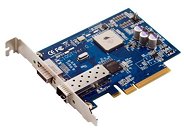Monday, August 16th 2010

Thecus Releases C10GT 10 Gbps Ethernet PCI-E Adapter
As digital files grow larger in size, the amount of data being transferred over networks is ever increasing. Today, Thecus Technology is pleased to announce the C10GT 10 Gbps Ethernet PCI-e Adapter. Featuring lightning-fast transfer speeds, dual cable connectivity, and simple installation and setup, the C10GT is a high-speed 10Gb ready network card designed to help users affordably take full advantage of the new upcoming 10Gb Ethernet standard.
The C10GT is a very capable and feature-packed network adapter. Powered by the enterprise-class Tehuti Luxor TN3020-D processor, the C10GT delivers efficient high-bandwidth access to server and storage applications, while requiring relatively low power for operation. Another standout feature of the C10GT is its dual cable interface, which features one CX4 port and one SFP+ port - perfect for accommodating both copper and fiber optic cabling.On the software side, the C10GT is an extremely flexible device which is easily integrated into almost any network environment. It is compliant with IEEE 802.3ae, IEEE 802.3ak, and IEEE 802.1q VLAN standards, and supports a multitude of widely-adopted operating systems, including Windows Server 2003, Windows Server 2008 / 2008 R2, Windows XP, Windows Vista, and Linux. The C10GT is also compatible with the Windows Management Interface (WMI), allowing administrators to easily manage both local and remote computers.
This full-height PCI-e adapter is easily installed in both PCI Express x4 and x8 slots, and can even be used to upgrade the following Thecus NAS devices to 10Gb Ethernet capability:
For more information on the C10GT, check out this page.
The C10GT is a very capable and feature-packed network adapter. Powered by the enterprise-class Tehuti Luxor TN3020-D processor, the C10GT delivers efficient high-bandwidth access to server and storage applications, while requiring relatively low power for operation. Another standout feature of the C10GT is its dual cable interface, which features one CX4 port and one SFP+ port - perfect for accommodating both copper and fiber optic cabling.On the software side, the C10GT is an extremely flexible device which is easily integrated into almost any network environment. It is compliant with IEEE 802.3ae, IEEE 802.3ak, and IEEE 802.1q VLAN standards, and supports a multitude of widely-adopted operating systems, including Windows Server 2003, Windows Server 2008 / 2008 R2, Windows XP, Windows Vista, and Linux. The C10GT is also compatible with the Windows Management Interface (WMI), allowing administrators to easily manage both local and remote computers.
This full-height PCI-e adapter is easily installed in both PCI Express x4 and x8 slots, and can even be used to upgrade the following Thecus NAS devices to 10Gb Ethernet capability:
- N7700PRO
- N7700+
- N8800PRO
- N8800+
For more information on the C10GT, check out this page.

12 Comments on Thecus Releases C10GT 10 Gbps Ethernet PCI-E Adapter
This is not for private use. Most people running a private network that is wired will not need nor entertain needing this. It is hard enough saturating 1 Gb Ethernet lines through a network.
And processing traffic does not and never will need that much CPU power. This will do nothing to a current gen processor with more than 1 core. Now processing traffic while doing other stuff maybe an issue, but you really thing a non-commercial server can saturate a 10GbE line with enough data to even require a CPU's "real" attention.
I could squeeze them into the budget where quad-port gigabit NICs are being used (I spent $400 each on a couple not too ago), but the switches are still pricey. Heck, I outfitted my last job with 4 x 48port switches for the same cost as some of the 8 - 12 port 10G models.
Before some people say 10GBps is faster its not because of overhead and latency Fibre channel has low overhead and 0 latency
A single UDP stream at 10Gb, running without offloading anything to the NIC is quite capable of overwhelming a dual core platform, and will put a dent in the resource pool of a powerful quad core system. If you have two or four 10GbE ports running at max capacity without offloading, then you can easily bring even a dual processor system to its knees.
As for the second statement, I refer to the industry insider part. As I simply pointing out as Easy did, this is not something you will have in your house. Small business, commercial server, etc. sure. As I believe, as you do as well, this will not be in a dual core UDP server, it will be in some 24+ core server array with plenty of CPU power available for it to eat up.
It seems we are arguing the same point here, so I digress.